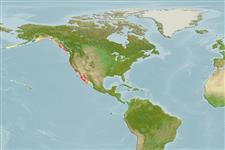Common names from other countries
>
Eupercaria/misc (Various families in series Eupercaria) >
Sciaenidae (Drums or croakers)
Etymology: Atractoscion: Greek, atraktos, arrow + Greek, skion, skiaina = barbel, red mullet (Ref. 45335).
More on author: Ayres.
Environment: milieu / climate zone / depth range / distribution range
Ecologia
marino demersale; distribuzione batimetrica 0 - 122 m (Ref. 2850). Subtropical; 65°N - 22°N
Eastern Pacific: Alaska to southern Baja California, Mexico and the Gulf of California.
Size / Peso / Age
Maturity: Lm ? range ? - ? cm
Max length : 166 cm TL maschio/sesso non determinato; (Ref. 40637); common length : 100.0 cm TL maschio/sesso non determinato; (Ref. 9118); peso massimo pubblicato: 41.0 kg (Ref. 2850); Età massima riportata: 20 anni (Ref. 56049)
Spine dorsali (totale): 10 - 11; Raggi dorsali molli (totale): 20-23; Spine anali 2; Raggi anali molli: 8 - 9; Vertebre: 24. Pelvic fins with fleshy appendage at base.
Often in schools over rocky bottom and in kelp beds (Ref. 2850). Also found in the surf zone (Ref. 2850). Young in bays and along sandy beaches (Ref. 2850). Feed on fishes, squids, and crayfish (Ref. 6885). Pelagic spawners (Ref. 56049). Excellent food fish (Ref. 9118).
Pelagic spawner (Ref. 56049).
Eschmeyer, W.N., E.S. Herald and H. Hammann, 1983. A field guide to Pacific coast fishes of North America. Boston (MA, USA): Houghton Mifflin Company. xii+336 p. (Ref. 2850)
IUCN Red List Status (Ref. 130435)
CITES (Ref. 128078)
Not Evaluated
Threat to humans
Harmless
Human uses
Pesca: scarso interesse commerciale; Pesce da pesca sportiva: si
Informazioni ulteriori
BibliografiaAcquacolturaProfilo di acquacolturaVarietàGeneticaElectrophoresesEreditarietàMalattieElaborazioneMass conversion
CollaboratoriImmaginiStamps, Coins Misc.SuoniCiguateraVelocitàModalità di nuotoArea branchialeOtolithsCervelliVista
Strumenti
Special reports
Download XML
Fonti Internet
Estimates based on models
Preferred temperature (Ref.
115969): 9 - 22.9, mean 12.8 (based on 76 cells).
Phylogenetic diversity index (Ref.
82804): PD
50 = 0.5312 [Uniqueness, from 0.5 = low to 2.0 = high].
Bayesian length-weight: a=0.00794 (0.00404 - 0.01563), b=3.07 (2.91 - 3.23), in cm Total Length, based on LWR estimates for this species & (Sub)family-body (Ref.
93245).
Trophic level (Ref.
69278): 4.3 ±0.70 se; based on food items.
Resilienza (Ref.
120179): Basso, tempo minimo di raddoppiamento della popolazione 4.5 - 14 anni (K=0.13; tm=4; tmax=20).
Fishing Vulnerability (Ref.
59153): High to very high vulnerability (70 of 100).
Climate Vulnerability (Ref.
125649): Moderate to high vulnerability (48 of 100).
